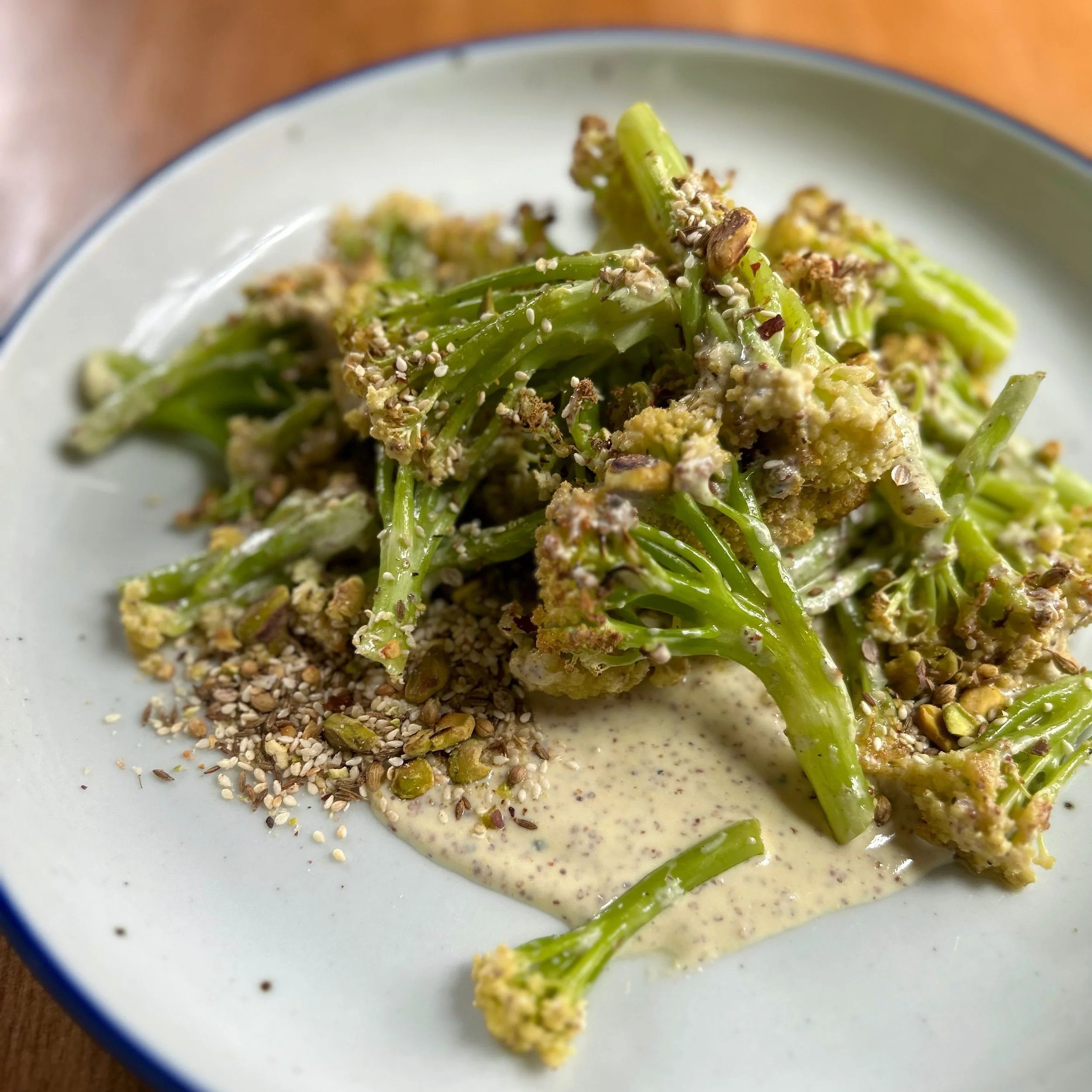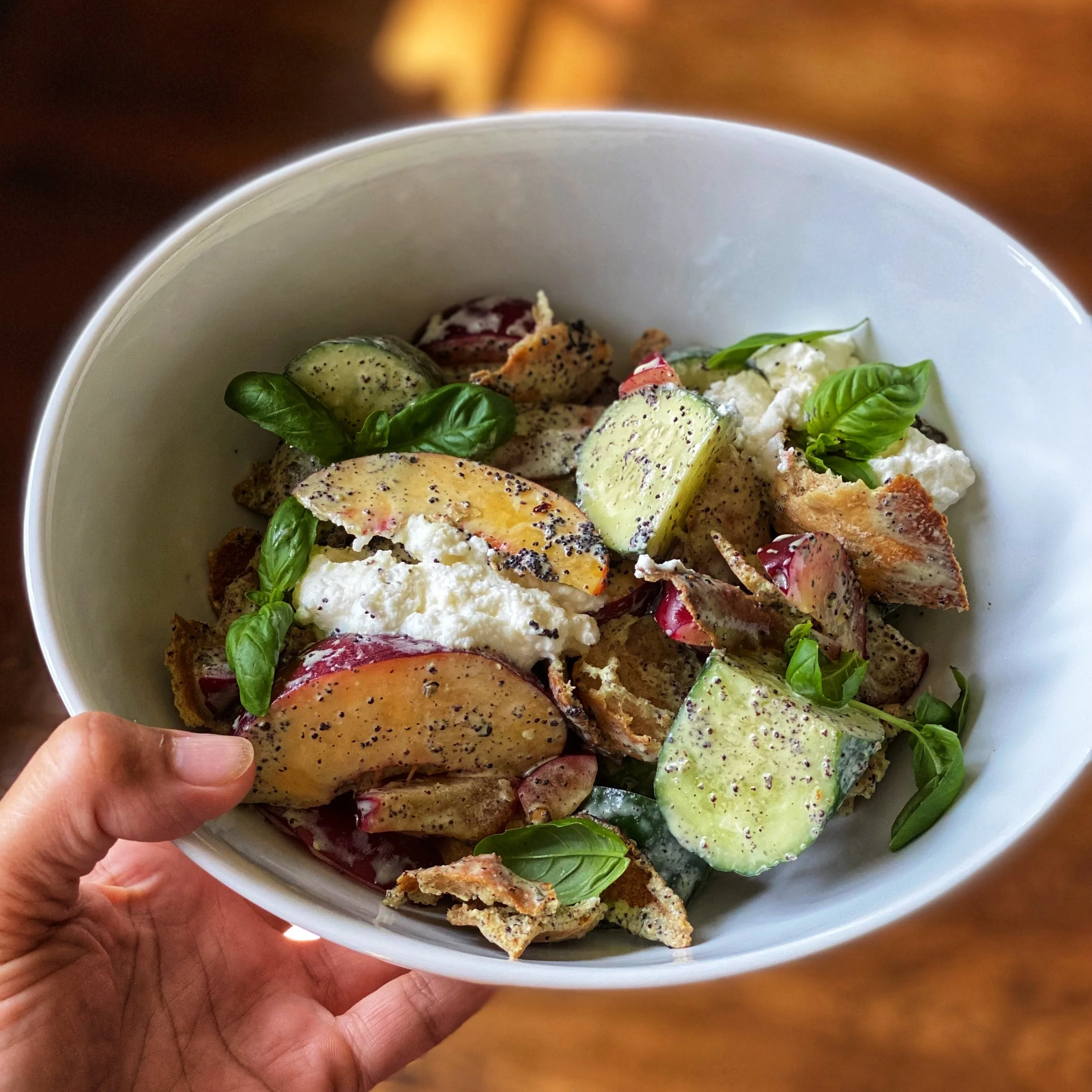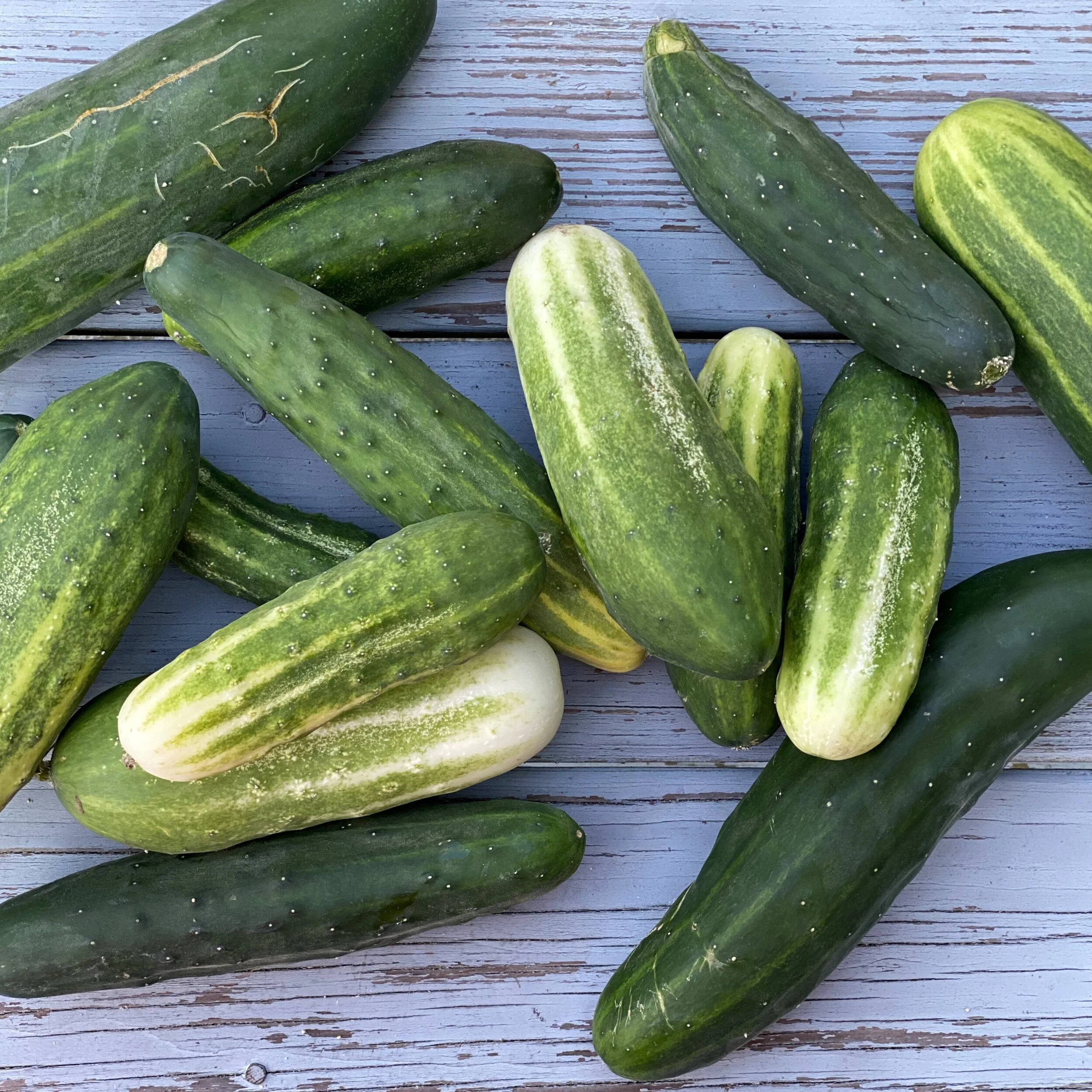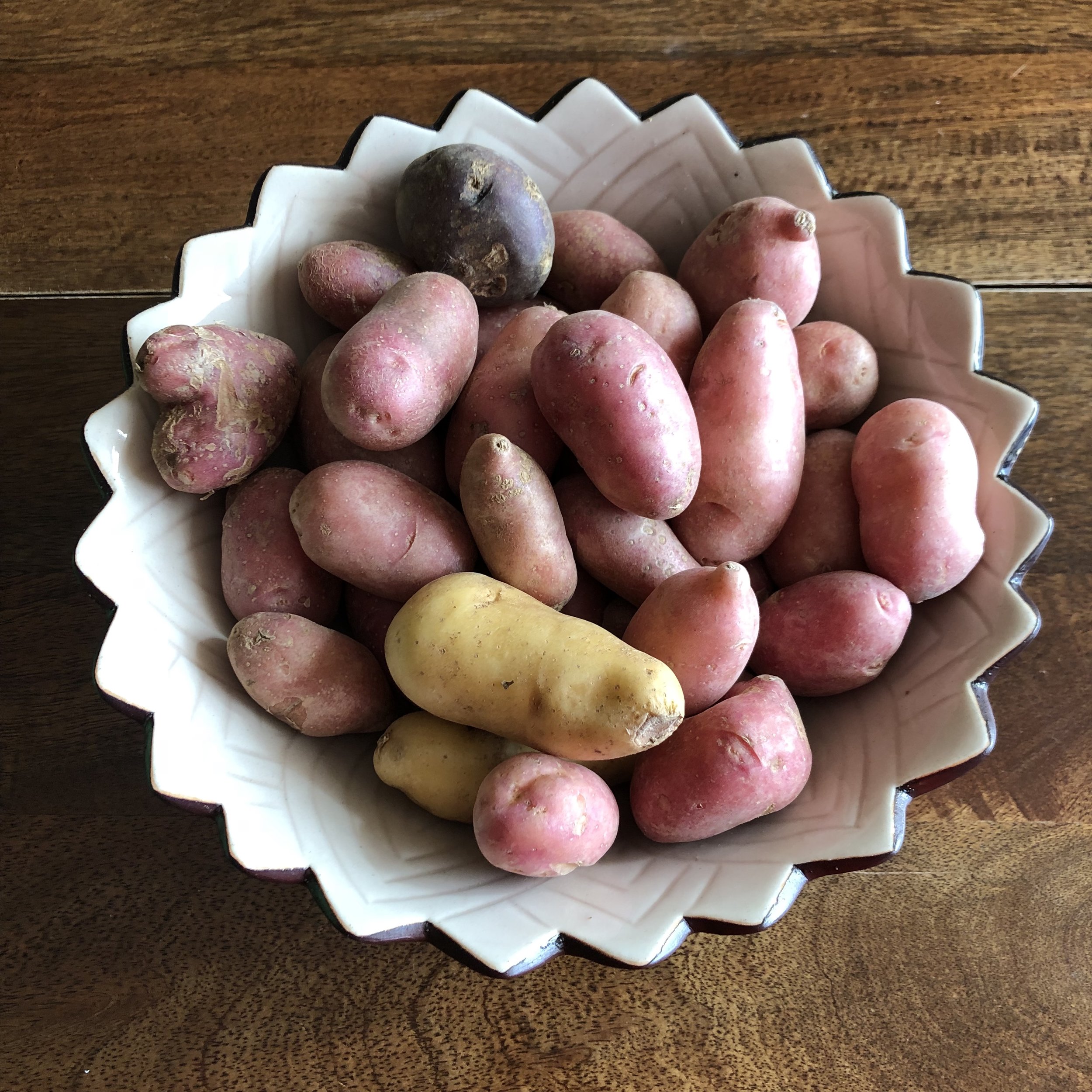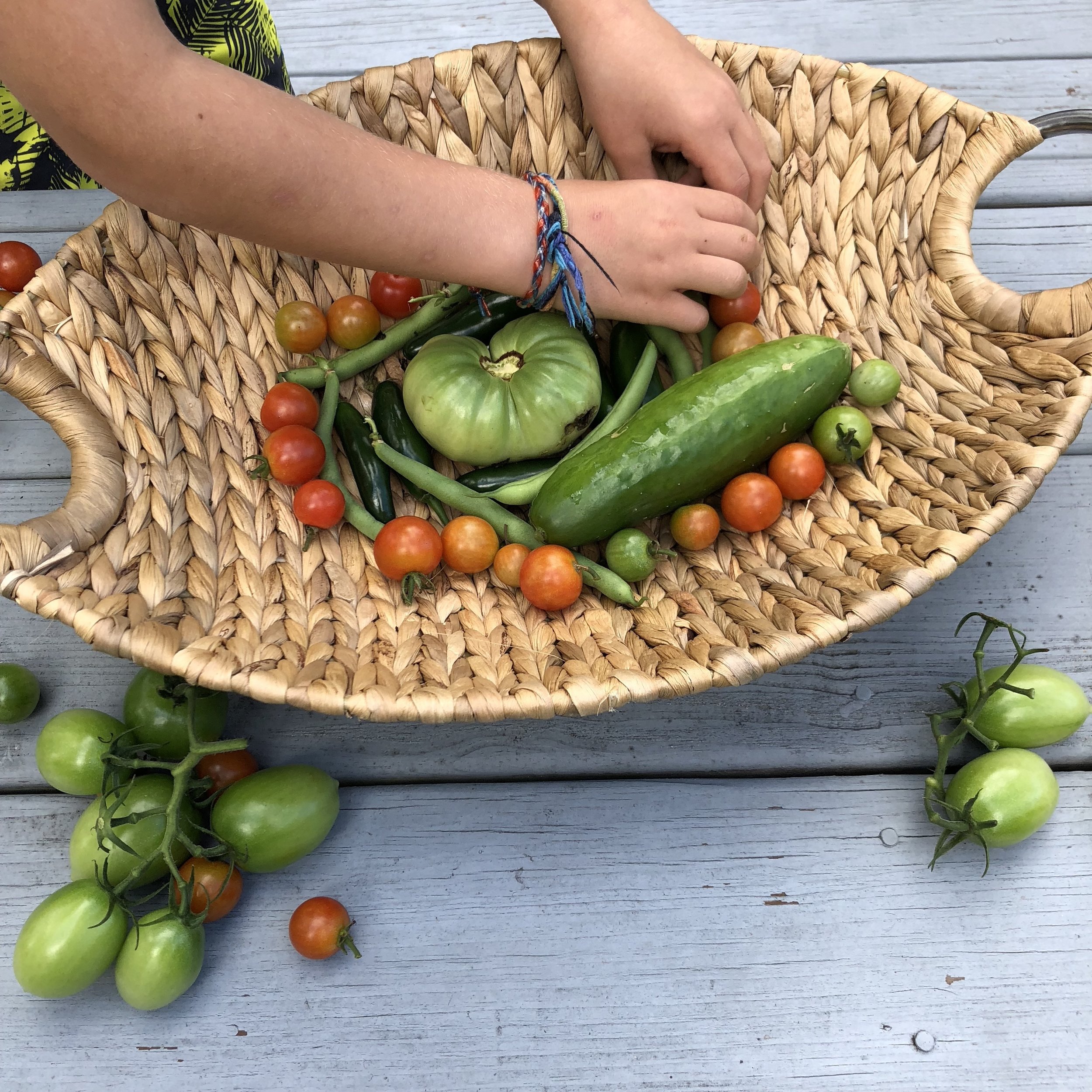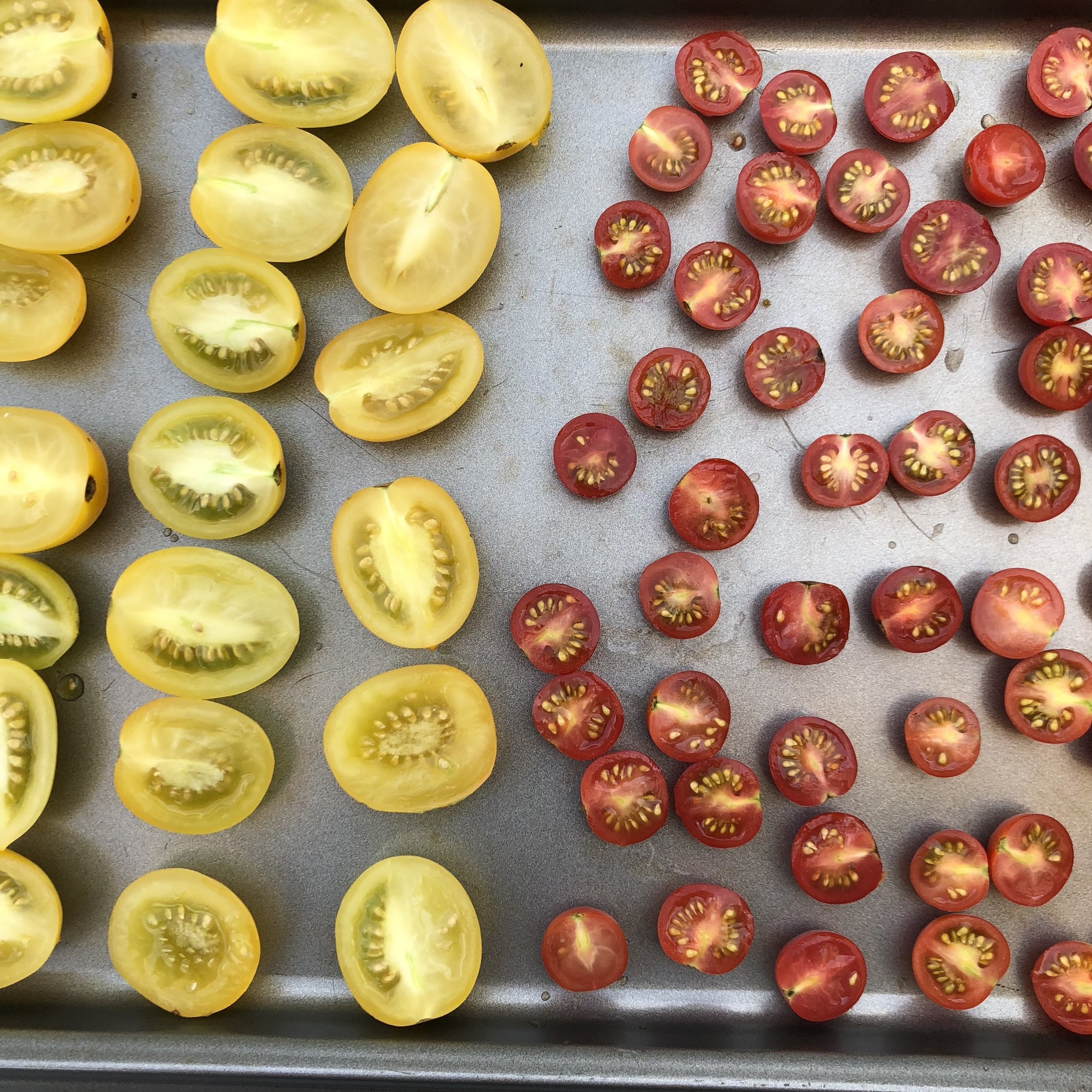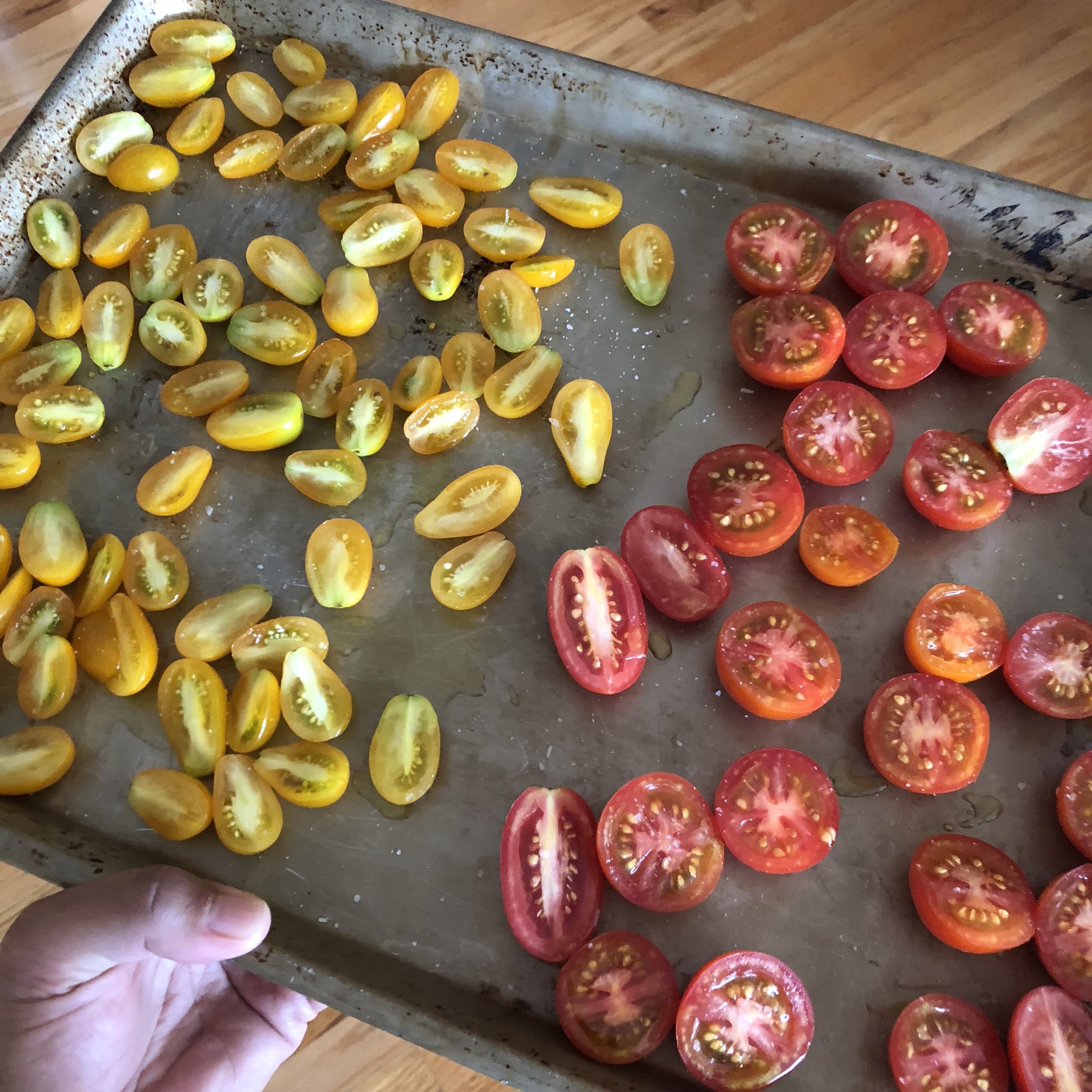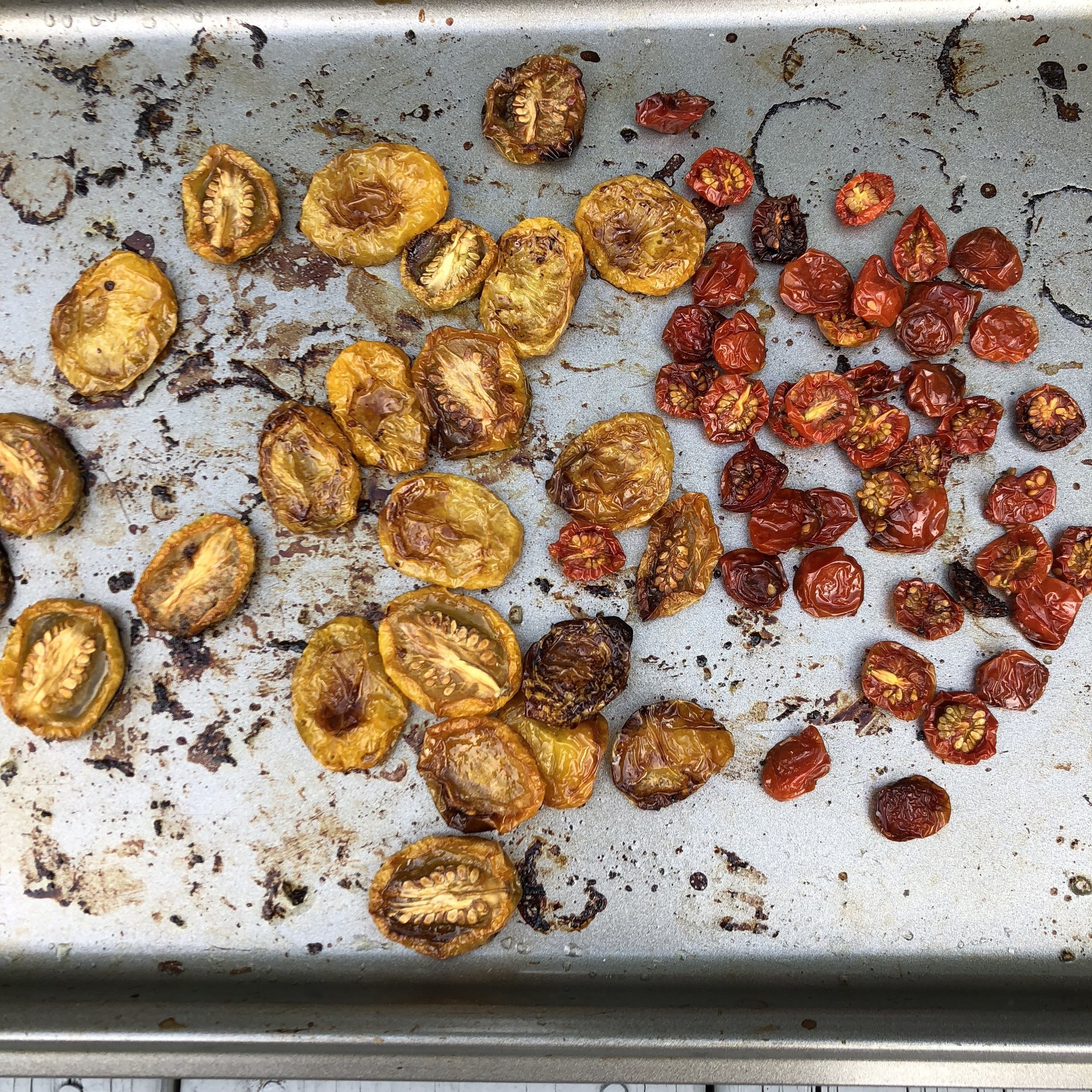In case you are suddenly finding yourself with more cukes than you know how to chill out with, this round up blog is for you. It’s a brainstorm of cucumber uses along with links to a few good recipes. What are your favorite uses for cucumbers? What am I missing?
Herb and Olive Oil Sourdough Crackers
An excellent use of sourdough starter discard, these crackers are addictively crispy, with a cheesy and nutty tang from the sourdough starter. And they are versatile. I like this combination of rosemary, thyme and parsley with the olive oil, but sometimes swap a blend with a broader assortment of flavors like fennel and lavender. My son likes replacing the rosemary and thyme with smoked paprika, garlic powder and cumin seeds.
Tuber Tutorial
Although we enjoy our potatoes year-round, their chance to shine starts with Thanksgiving and continues through the cooler months, when we gobble up this “storage” crop.
Years ago, while studying abroad in Nepal, I understood first hand what this meant. I arrived at one homestay in the snowy mountain region of Annapurna just after the potato harvest and actually had the privilege of bunking up with the family’s potato stores. Those potatoes, overflowing from large wicker baskets in a cold dry loft above the hut would last them through the cold winter, primarily boiled and dipped in Himalayan salt.
Here, we treat ourselves to mashed potatoes at the holidays, incorporate them in our winter stews and roast them alongside chickens for Sunday dinner. Nothing says winter comfort food quite like a potato. But there are as many varieties of potatoes as dishes we make with them.
Farmer Ted (our CSA hero farmer from upstate NY) supplies at least 7 varieties each year, not even including the sweets and yams. I'm often asked, what's the difference between all of these spuds. I mean, a potato is a potato, right? Right. Um sorta. So why do I need all of these different varieties?
Well, each variety provides different nutrients and things we need for optimal health. You could read up on it in Jo Robinson's impeccably researched book, "Eating on the Wild Side" or you could just take my word for it. Okay, so variety of potatoes, yah, yah, yah, can I just cook them all the same way? Sure, you could. Potatoes are delicious pretty much any way you slice 'em, or roast them or boil them or you get the picture, but in my kitchen experience, I have found that some potatoes just lend themselves better to certain things than others...
Fingerlings of all shapes and colors are best when halved (or kept whole if really tiny), tossed in olive oil and salt and roasted in a hot oven (say 400 degrees) until crisped on the outside. I like adding fresh or dried hearty herbs like rosemary, whole garlic cloves, and whole spices like cumin seeds to mine too. These are also the best variety for slicing thinly for a tart, to top a pizza or elevate a salad.
Russet potatoes: there's a reason you often see these baked whole at steak houses. They make the best baked potatoes and vessels for all of those toppings, like butter, sour cream, cheese, broccoli, bacon, and of course they are great for twice baked or stuffed potato skins. But what you might not realize is that leftover baked Russet potato flesh is perfect to form into gnocchi, or mix into croquettes or veggie burgers. They don't add too much moisture and their starches are useful for binding other ingredients together.
I use Yukon golds and red potatoes in pretty much everything else, like all sorts of mashed potatoes - garlic mashed, sour cream and chives, with gravy, I'm drooling for Thanksgiving now. Justifiably so, they go by the term “creamer” potatoes in some places. They are also my go to for chowders, all stews including My Dad’s Beef Stew, my Auntie Sheila's Puerto Rican Rice and Beans recipe, latkes, and for filling pierogi.
As we near Thanksgiving 2018, I feel compelled to provide an important public service announcement in regards to potatoes. Whichever variety you use for your mashed potatoes (although I recommend the yukon golds or reds), please DO NOT whip those potatoes with an electric mixer nor put them into a food processor. You may think this will help get a smooth and creamy consistency, it WON’T. While your potatoes may end up “lump free” they’ll be so gummy and gluey that you won’t be able to appreciate the absence of lumps. If you really want to make a mash in a food processor, then consider Creamy Mashed Cauliflower instead.
Green Tomato Envy
As the longer days and warm weather winds down, the final baskets of heirloom red tomatoes and rainbow colored cherry tomatoes are available at farmer’s markets. Scoop them up while you can. However, you can rest assured that green tomatoes will appear over the next couple of weeks. I’ve got you covered for what to do with those green tomatoes - and it goes beyond frying ‘em.
Acknowledging their fate, I plucked quarts of green tomatoes from my tomato plants last weekend. They will never realize their potential colors promised on the seed packets. And that’s okay. I’m appreciative for the shorter days and cooler temps, especially when I dream up all of the good eats from these firm and punchy green ovals. I started with this tangy and spicy green tomato chutney. Over the weekend, we ate it with grilled pork chops, but it’s also delicious alongside this Bengali Red Lentil Dal or just slathered on bread.
Tangy and Spicy Green Tomato Chutney
Yield: 1 ½ - 2 cups
What you need:
4 cups green tomatoes, chopped into about ⅛ inch pieces
¼ cup sugar (I used turbinado or raw sugar)
2 teaspoons salt
3-6 serrano chilis, jalapenos or other small green chilis, halved, seeds removed & thinly sliced
2 teaspoons coconut oil (optional)
⅓ cup honey
1 whole star anise
8 cardamom pods
2 tablespoons to ¼ cup lime juice
What you do:
Combine the tomatoes, sugar and salt. Allow to sit for 30 minutes to 1 hour, stirring occasionally.
Strain the liquid from the tomatoes. Discard the liquid and transfer the tomatoes to a medium saucepan.
Add the sliced chili peppers, coconut oil, honey, star anise, and cardamom. Stir and bring to a boil. Reduce heat and simmer for 45 minutes.
Add lime juice to taste. Simmer another 10 minutes or until lime juice is reduced.
If chutney is not your jam, you might try these other ideas for an abundance of tomatoes, equally delicious with green tomatoes as well as their peak season rainbow colored cousins:
Emory enjoys arranging the bounty baskets even more than he enjoys picking produce from the garden
Here’s one of his arrangements.
Slow Oven Dried Tomatoes:
What you need:
tomatoes (any and all colors)
extra virgin olive oil
kosher salt or sea salt
garlic, dried oregano, dried basil, red pepper flakes (optional)
What you do:
Slice cherry and grape tomatoes in half.
Arrange in a single layer cut side up on a baking sheet. Drizzle with olive oil. Tip: If your olive oil comes out too fast or doesn’t drizzle nicely from the bottle, transfer some to a spoon or small liquid measuring cup and drizzle from that.
Sprinkle with kosher salt or sea salt.
Roast in oven at 200-225 degrees for at least 2 hours. Check at 2 hours. You want tomatoes to be shriveled and dried (see bottom photo on right). They should move easily around the pan when you shake it. Continue roasting, checking every 15-30 minutes until you reach this state. You can store in the fridge up to 3 weeks as is or in a jar of olive oil, with or without additional seasoning, like roasted garlic cloves, dried oregano, red pepper flakes or dried basil. You can also freeze the roasted tomatoes in oil for up to 6 months.
Tomato Jam:
I made a version of this sweet and spicy tomato jam, but I used about 3 lbs of tomatoes because that’s what I had. I reduced the amounts of other ingredients accordingly. In addition to tomatoes, my jam has ¼ cup apple cider vinegar, ½ cup Mike’s hot honey, ¼ cup orange blossom honey, ¼ cup turbinado sugar, ¼ cup white sugar, and ¼ teaspoon crushed red pepper. I basically followed the procedure and got 16 oz of jam (or four 4 oz ball jars). I want more! Increase the sugar if you use green tomatoes, unless you like a more tart jam.
Fresh Tomato Tart:
A classic tomato tart, like this one from Ina Garten is a beautiful picnic or fall potluck take along. Or try this one using green tomatoes that really seems more like dessert than a savory dish.
Fried Green Tomatoes:
There is no substitute for fried green tomatoes, so make some this weekend and share. I’m pretty sure I’m available. Call me. To make: Slice large green tomatoes into 1/4 - 1/2 inch thick rounds. Put them through a three step dredge: 1. Flour seasoned with salt and cayenne pepper, 2. Egg whisked with salt and black pepper, and 3. Coarse ground cornmeal (with more cayenne if you’re feeling spicy). Fry in canola oil until golden brown on each side, remove and set on paper towels to drain, and sprinkle with salt immediately.
Just a chef showing off her tomatoes, and getting some sun on her guns.
What's in my pantry?
Local seasonal cooking or the “use what you have method” is reliant upon a well-stocked pantry of easily adaptable staples. Since I often talk about what I find in my pantry to combine with unexpected pounds of fresh produce to assemble a quick dinner, many of you have asked, “what should be in my pantry?” As a chef, baker, and overall food enthusiast, my pantry is abnormally stocked with 6 types of rice, 8 varieties of flour, an assortment of oil and vinegar bottles and nearly 70 spices and dried herbs, and counting. What can I say, I love spices! However, for the purposes of this post, I asked myself, “what 10 items would you keep if you had to limit your ingredient indulgence?” In other words, below are the top 10 items I always have on hand.
Note: Your well-stocked pantry is going to have a lot to do with the type of cooking you do and the diet you eat [or aspire to eat]. This is my version.
Red Lentils (and Bengali Red Lentil Dal)
Freekeh
Dried Cranberry Beans
High Quality Extra Virgin Olive Oil - Mediterranean diet, need I say more?
Canola oil - sometimes you need a health supportive cooking oil that won’t impart olive flavor
Apple Cider Vinegar - when I thought about it, this is the vinegar I use most in sauces, dressings, marinades, and even stews and bone broth
Dry Pasta - with my Italian roots and carbohydrate loving family, we’re often one box of pasta and some veggies away from dinner
Coconut Milk - for a quick curry, a creamy soup, “nice” cream, or overnight oats, it’s good to have this stuff around
A variety of Spices but only those you’ll use within a year. In the spirit of this post, if I had to choose one and only, I’ll take crushed red pepper flakes, since I use them nearly every day.
Red Lentils - fast cooking, no soaking required, endless possibilities…
A whole grain, and if I had to choose right now, it would be Freekeh, because it’s freaking delicious
Dried Cranberry Beans - New England favorite, they work in chili, make kick-ass beans and rice, and can be puréed into a smooth dip
Canned Chickpeas - I often cook my own chickpeas but having canned beans on hand for unplanned uses is critical and chickpeas are of the most useful
Okay, so ten items is extremely limiting; I’m including a bonus 5 items for bakers:
Turbinado Sugar
Unbleached All Purpose Flour - I bake with a variety of flours and meals, but you can’t beat all purpose, because, well it’s for all purposes, and I usually combine that with another variety like spelt or whole wheat
Turbinado Sugar - This raw version is less refined and offers more texture and flavor than its white counterpart, but it’s also versatile and can be used in most baking recipes that call for white and/or brown sugar. It can also be ground if you need it finer.
Baking Powder - Sometimes you need a leavener…and this works more often than baking soda which requires acid in the mixture. Admittedly, this baker uses both regularly.
Rolled Oats - these can also be ground into oat flour using a spice grinder or food processor
Pure Vanilla Extract - usually can’t go wrong with this addition to most sweets…
I forgot salt?! Bonus item: Kosher Salt. So, there you have it. 16 required items in my pantry.
Shopping in your Freezer
Miso Ramen Noodle Soup with Broccoli, Edamame and Jalapeno
Every once in a while, I attempt to dig out my freezer and use up all of its contents, to save $ at the grocery store and free up space for new creations and the bounties I'm anticipating from local crops. It's my version of spring cleaning, aptly named using a term coined by my Grammie. She routinely bears gifts of clothing, fabric and housewares. When asked if she's been shopping, she says, "oh yes, shopping in my closet!"
I've been sharing some of my recent mouth-watering creations out of goods I found stashed in my freezer, which prompted many of you to ask, how big is your freezer? How do I get that out of my freezer?
So, in response...
...my freezer is pretty standard. I live in a Brooklyn apartment, after all.
...here's a list of my tips for finding ingredients and inspiration in your own freezer. Armed with these, you too can make a quick meal, prevent waste and avoid the grocery store, but you might also discover a new family favorite, test your culinary muscles and make something out of the ordinary.
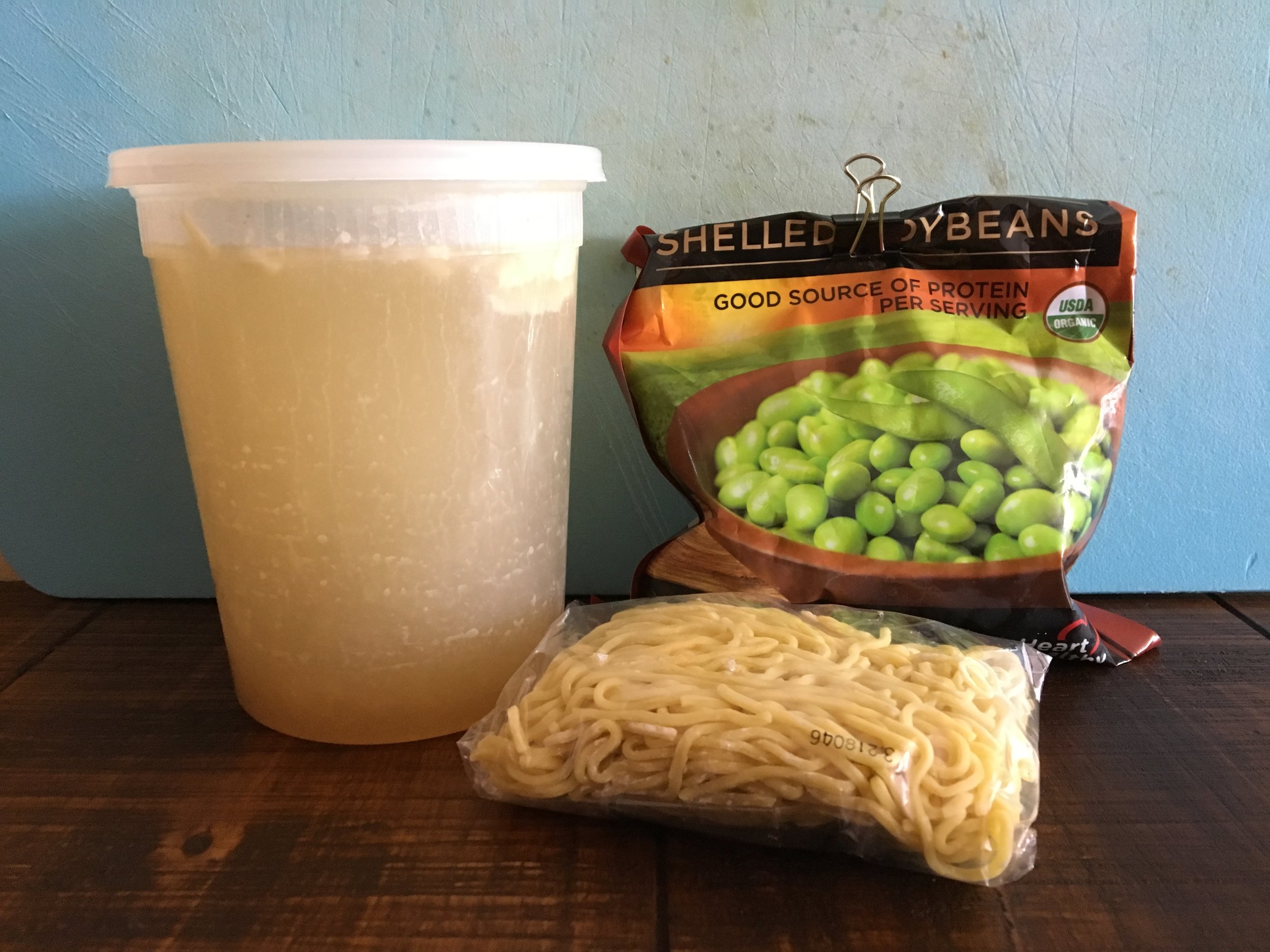
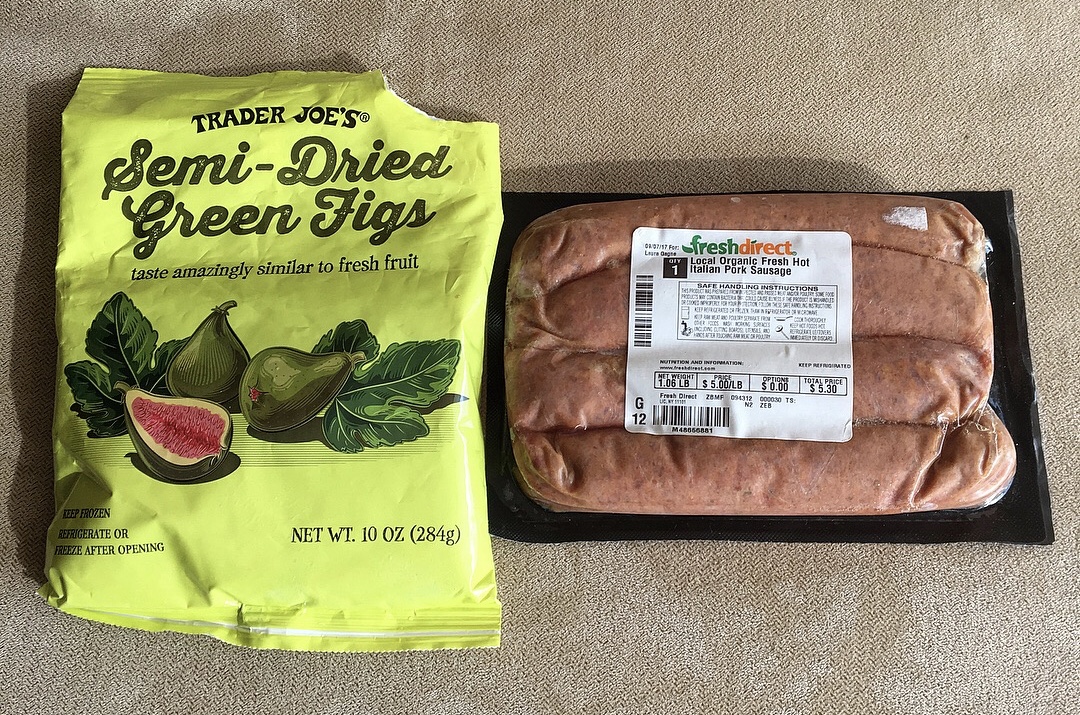

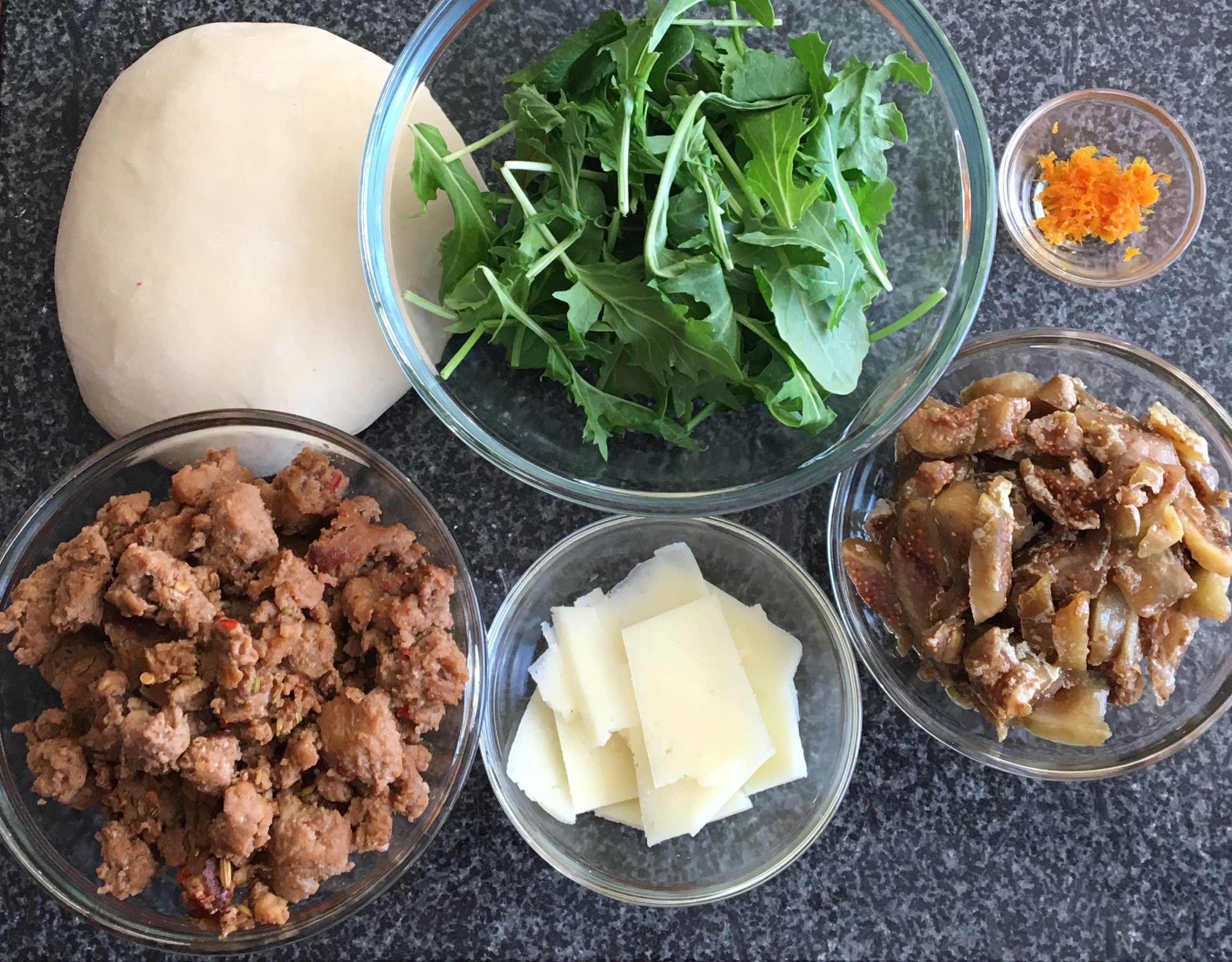
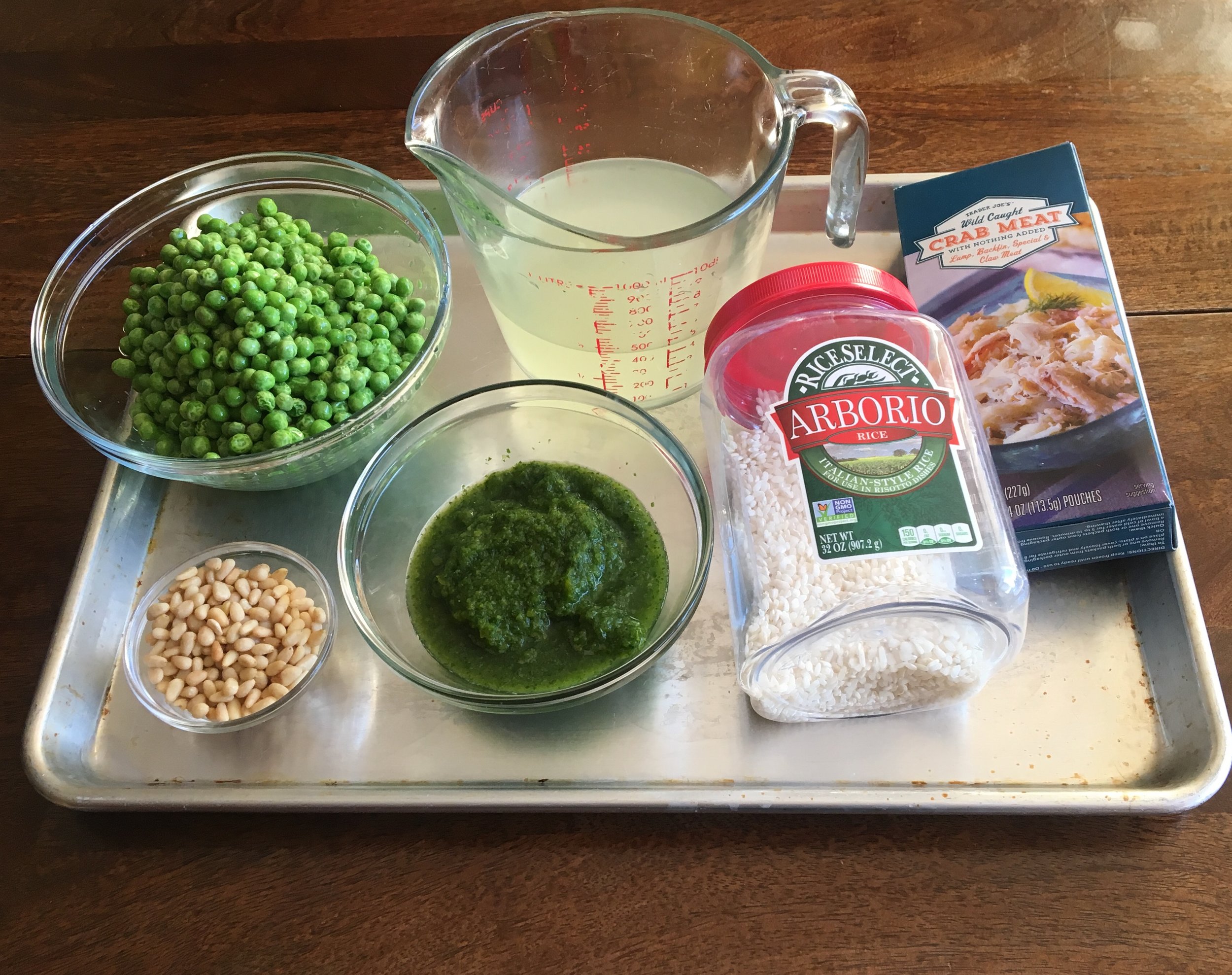
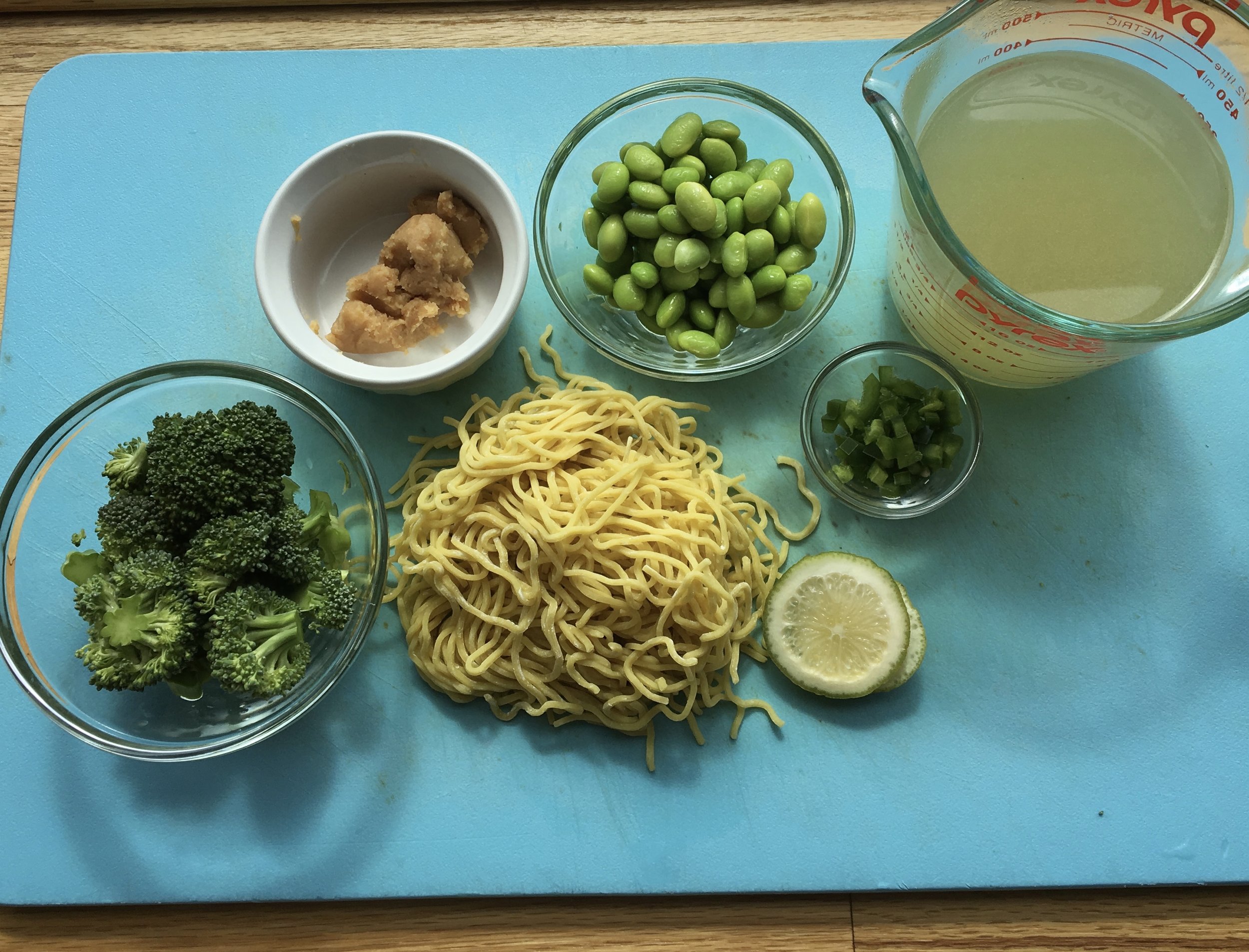

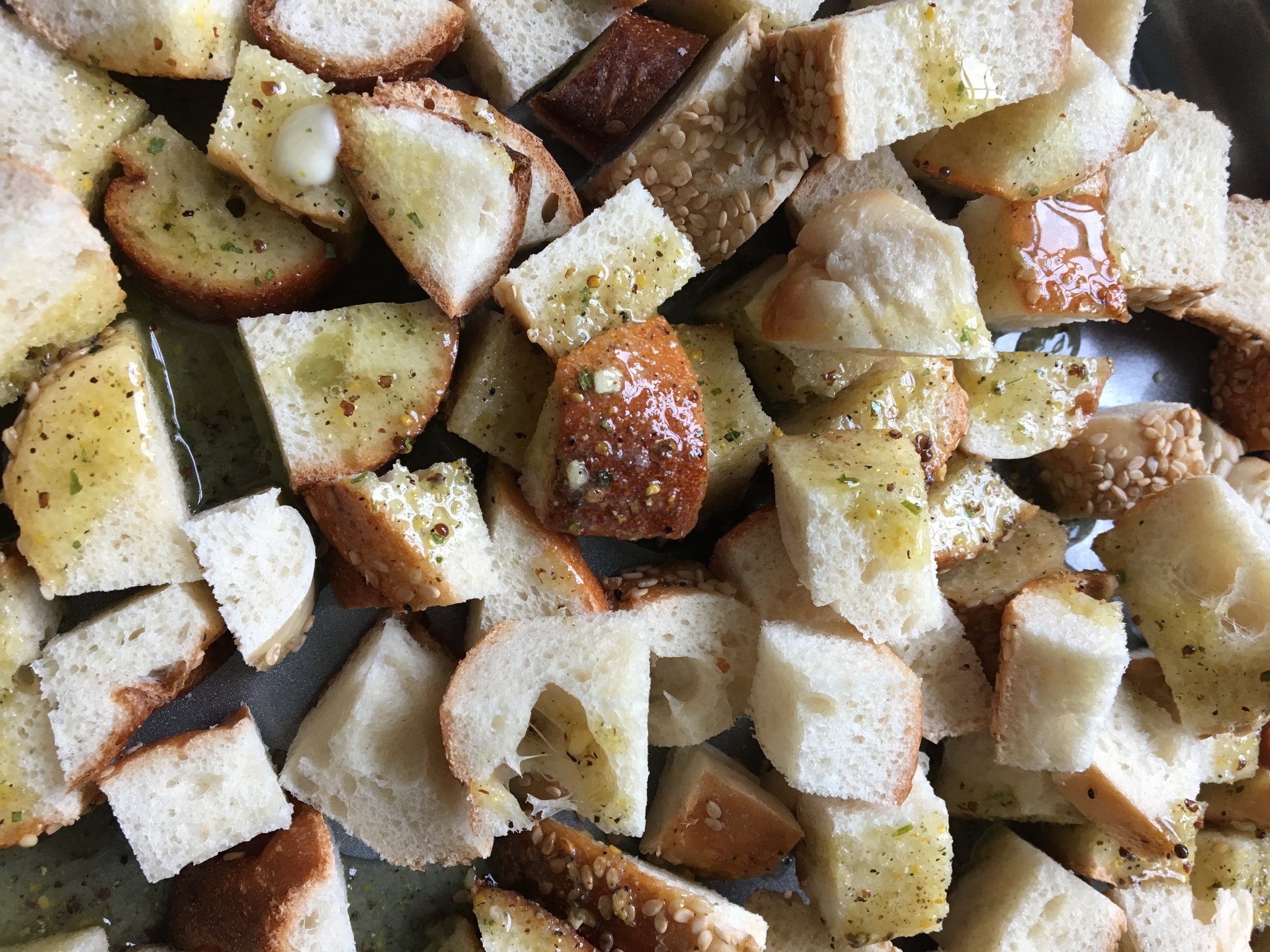

Organize it. Occasionally, take everything out of the freezer and sort it, consolidate similar items and return them to the freezer in an organized fashion. For example, put all animal proteins in one corner, vegetables in another, and stack ready-made meals, like soups and stews together. I also use a narrow bin for lining up my purées and sauces in their liquid storage bags (I use re-purposed breast milk storage bags I have in excess).
Choose wisely. Either randomly select two items, such as one protein and one vegetable to give yourself a challenge or choose two to three items you know go together well (more on that later). Better yet, have your partner, child, roommate, or sister that you're texting, choose the items for you. Set those chosen items in the fridge or out to thaw. Now you're stuck with those, Chopped style. So make it work.
Use formulas. Refer to a list of go-to recipe templates. The types of recipes I'm talking about are best described as "plug and play". Think of general recipes that have a base, a procedure you are familiar with, and a few interchangeable components. My templates include pasta dishes, soup, stew, muffins, quiche, pizza, risotto, grain bowls, pot pie, or stir fry.
Brainstorm flavor combinations. Determine which ingredients and flavors go together. Did you just take peas and ground turkey from the freezer? So ask yourself, what else do I make with peas or what spices and vegetables were in that poultry dish from my favorite restaurant? Or conduct a quick internet search for recipes by ingredient. One resource I love for brainstorming flavor and ingredient combinations is the Flavor Bible. A dear friend gave me this book years ago and I still reference it weekly. Just learned that there is a Vegetarian Flavor Bible now too.
Ignore measurements. It does not matter if the package is half full, or if you don't have as much sauce as you usually use. It's not an exact science. Just add more or less liquid or crunch as needed.
Set a time limit. Again, Chopped style. If you limit how much time you have to either think about what you are going to make with the freezer finds or actually cook dinner or both, you will force your creative side without losing too much time.
Re-purpose freezer finds. Turn something you don't like into something you love or that the kids and picky eaters of the world will eat. Change the texture and overall structure of the ingredient. For example, I had a purée of steamed sweet potatoes, apples and carrots that the baby suddenly turned his nose up at (after liking it for a few months). That purée just became the star ingredient in my famous sweet potato waffles. And all the rejected old bread ends that will never qualify for a BLT or PB&J make beautiful garlicky croutons for a panzanella salad.
Allow yourself an out. You do not have to eat your failures. If it is truly terrible, you can toss it, compost it or feed it to the dog. It's okay, you shopped in your freezer and you gave it a try. Or you might even re-purpose it to another step. We made a risotto out of crab meat, sofrito and peas. It was just okay, and there was a lot remaining, so rather than force ourselves to eat the leftovers, I thought, why not mix in some cheese, roll into balls and pan fry for arancini magic!
And many of you want to know, how do I get all of these things into my freezer to begin with? That's a topic for another day or series of posts. Stay tuned and in the meantime, see here for my chowder freezing tip.

